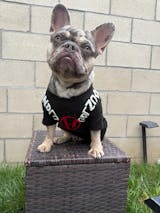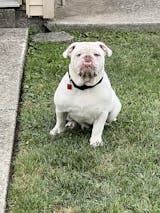Why You Need Wrinkle Paste if Your Dog Has Tear Stains
One symptom dog owners often overlook in their dogs is tear staining. Some dog owners may not even know that the dark stains under their dogs eyes are actually a sign of tear stains.
So, what are tear stains in dogs and why can’t you just ignore them? This article will help shed some light on the issue of tear stains in dogs, what causes tear stains, and the best way to address tear stains on your dog.

What Are Dog Tear Stains?
Tear stains are the red or brown colored stains visible under dogs eyes. If you regularly notice a buildup of stained fur beneath your dog’s eyes, this is a good indication your dog suffers from tear stains. Red tear stains are typically caused by porphyrin, a pigment found in tears. This pigment then builds in the eyes and can cause some severe issues for your dog over time. Brownish, rust-colored tear stains are typically a sign that the dog has a yeast infection, which can be caused by something in their diet. Once you start to notice either red or brown colored stains under your dog's eyes, it is time to take action to help prevent tear stains on your dog.
Aside from being unsightly, tear stains are also a sign that your dog may have an underlying health issue. Tear stains in dogs are typically a result of epiphora, which means they have excessive tear production or an inability to properly clean away tears or other moisture from the eyes. When tear stains start to build-up in your dog’s fur, that means that there’s also fungus, bacteria and moisture breeding on your dog’s fur. Yuck!
What Types of Dogs Have Tear Stains?
There are many different dog breeds that can experience tear stains. Short-faced breeds are particularly vulnerable to these types of tear stains. English Bulldogs, French Bulldogs, Pugs, and Shar Peis are just some of the dog breeds that are prone to tear stains. But they’re not the only ones! Dogs with white or light-colored fur can also be vulnerable to developing tear stains, including Maltese, Shih-Tzus, and Poodles, to name just a few.
Underlying Causes of Tear Stains
There are several medical issues that can lead to tear stains in dogs. Glaucoma can cause fluid buildup in the eye and damage to the optic nerve. In puppies, teething can also cause a large amount of tears and lead to tear stains. Also, ear and eye infections, large tear glands, and ingrown eyelashes can all cause more tear production and lead to tear stains in dogs.
Your dog’s diet and lifestyle can also have an impact on tear staining. A balanced diet and low levels of stress are important to having a healthy dog free of tear stains. Avoid feeding your dog foods that are filled with preservatives, artificial flavors and colorings, and cheap fillers. Also, the type of serving dish you feed your dog in can also make a difference when it comes to tear stains. Many studies have shown that plastic can leach chemicals into your dog’s water or food. Avoid using plastic serving dishes and instead opt for ceramic or stainless steel dishes when feeding your dog.
How to Get Rid of Dog Tear Stains
Fortunately, there is a way that you can get rid of tear stains on your dog! The best way to get rid of tear stains is to keep the area clean and dry to prevent your dog’s fur from becoming a breeding ground for bacteria and fungus. Start by cleaning the area thoroughly with Squishface Wrinkle Wipes. Then, apply Squishface Wrinkle Paste to the affected area. Rub a small pea sized amount of Wrinkle Paste vigorously into the fur and onto your dog’s skin.
Squishface Wrinkle Paste contains natural zinc oxide and coconut oil to create a water repellent barrier in order to keep that nasty fungus and bacteria at bay. Not only does Wrinkle Paste help to get rid of those unsightly tear stains, it helps to prevent tear stains from returning. While many happy dog owners begin to notice a difference in the appearance of tear stains after using Wrinkle Wipes and Wrinkle Paste after just a few days, we recommend using both products together daily for a minimum of 7 to 10 days for best results.
The Bottom Line:
If you start to notice reddish or brown stains under your dog's eyes, don’t just ignore them. Your dog’s tear stains are usually a symptom of an underlying issue such as diet or lifestyle, or even a more serious medical issue. Keeping the area clean and dry is the best way to address and prevent tear stains from forming. Using Wrinkle Wipes and Wrinkle Paste together is the most effective way to address your dog’s tear stains.
Be sure to follow us on TikTok, Instagram, Facebook, Pinterest, YouTube, and visit our blog weekly for more tips on caring for your pampered pup, and the latest on all things Squishface!










